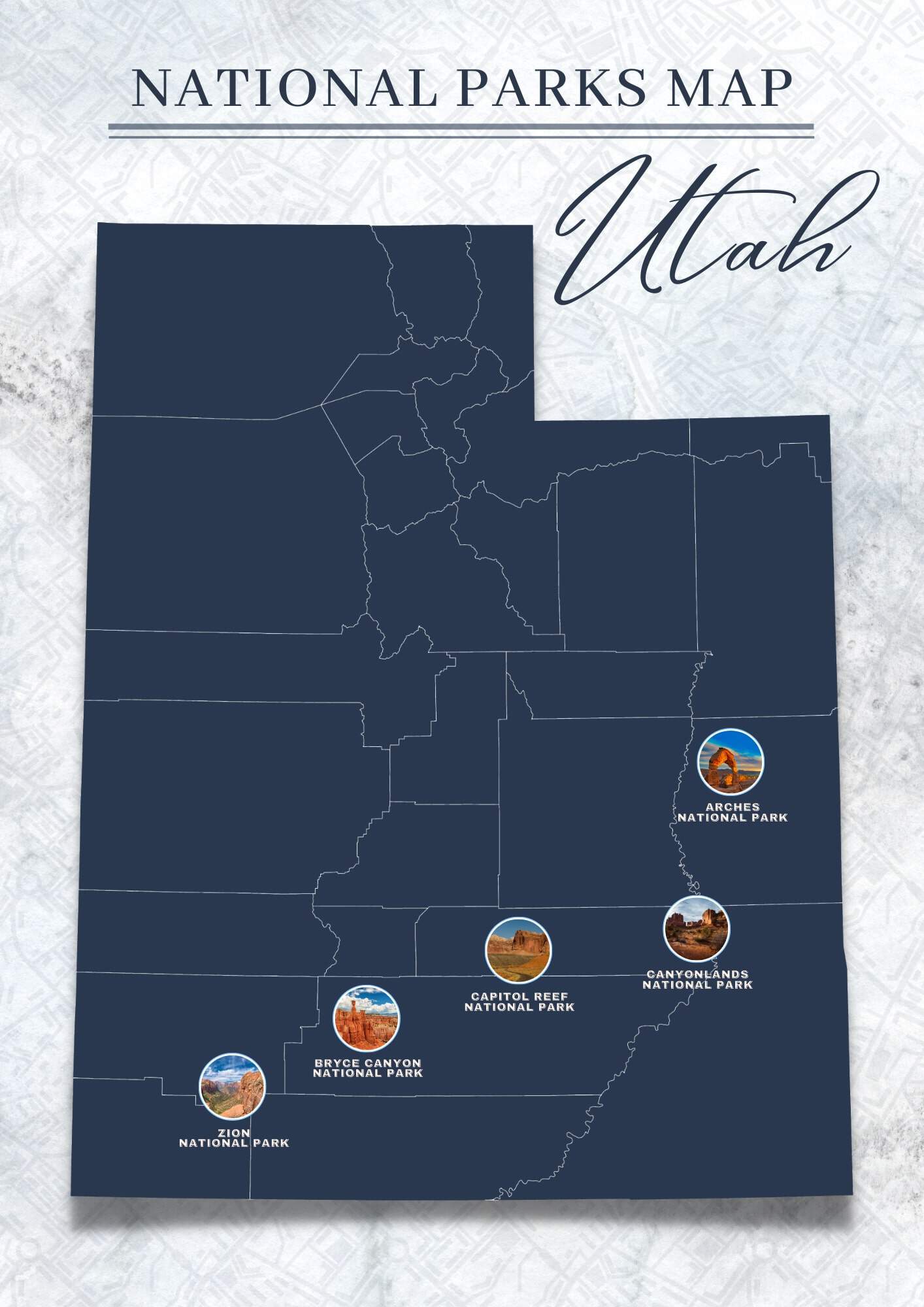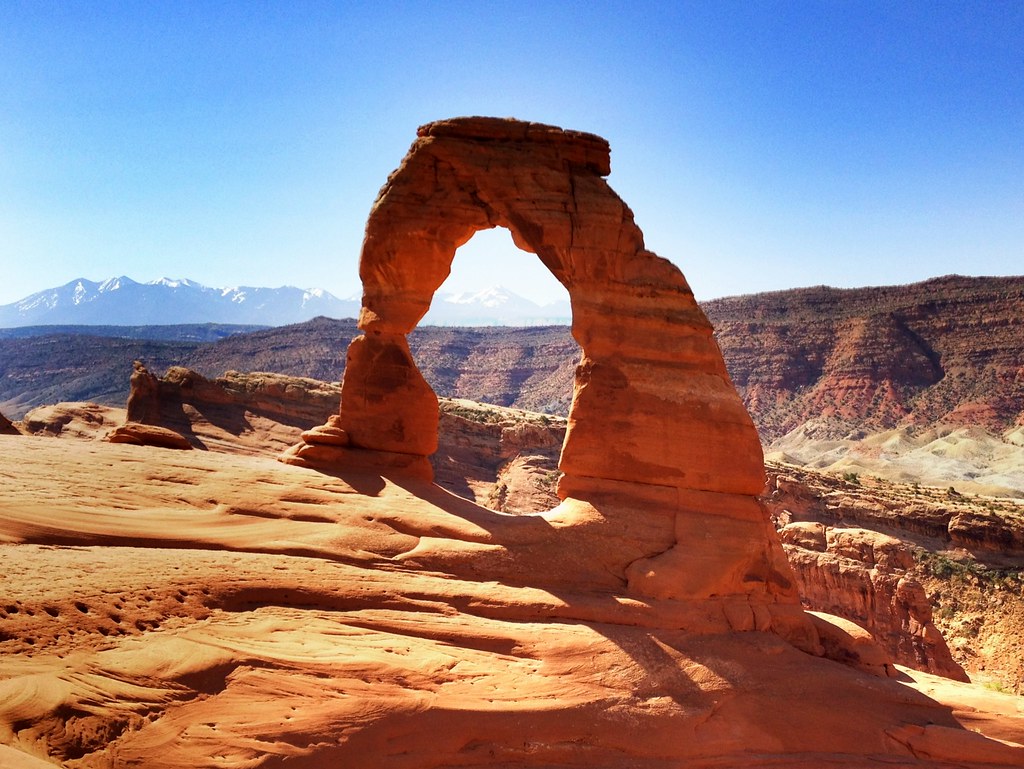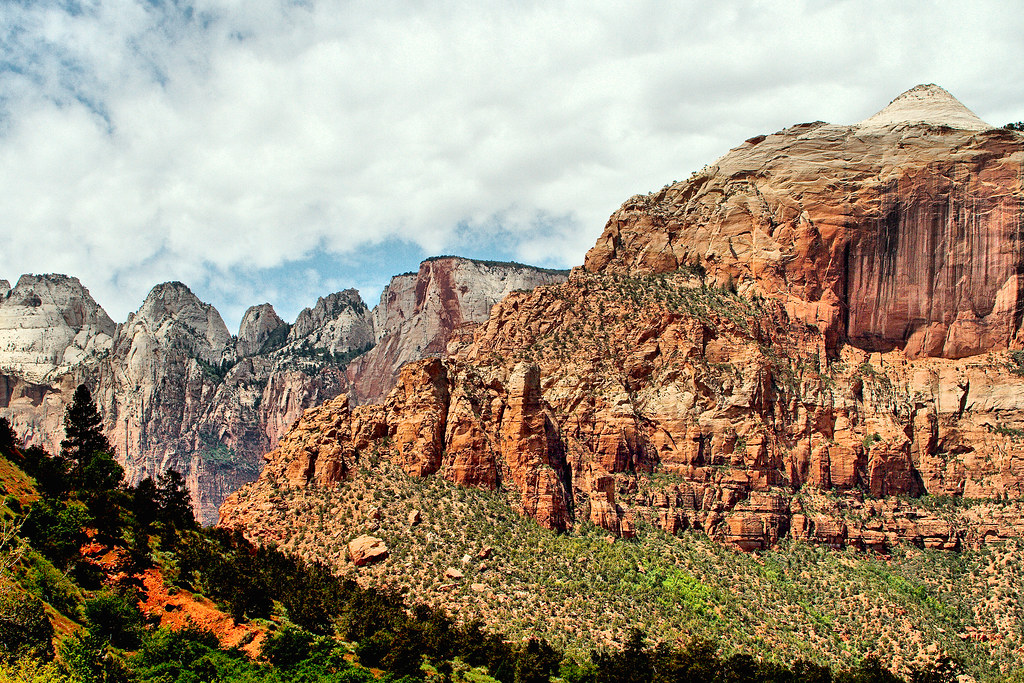Utah is home to five stunning national parks, each with a unique landscape and attractions.
These parks are visited by millions of people every year, drawn by the beauty of the red rock formations, towering cliffs, and breathtaking vistas.
While each park is worth visiting on its own, exploring them all can be a daunting task. That’s where a Utah National Parks Map comes in handy.
Printable Utah National Parks Map

Arches National Park
Arches National Park is located in eastern Utah, just 5 miles north of Moab. The park covers an area of 76,679 acres and is home to over 2,000 natural sandstone arches, making it one of the world’s most famous geological wonders.
The park’s iconic Delicate Arch is a must-see, especially at sunrise or sunset, when the rock formations are illuminated with a warm glow that makes for an unforgettable experience.
Visitors to Arches National Park can explore the park’s many hiking trails, which range from easy to strenuous. Some of the most popular trails include the Devil’s Garden Trail, which takes visitors past a collection of arches and rock formations, and the Fiery Furnace Trail, which leads through a maze of narrow canyons and towering rock walls.
For those who prefer a more leisurely experience, the park also offers scenic drives, including the 18-mile Arches Scenic Drive, which takes visitors past many of the park’s most famous landmarks.
The park is easily accessible by car, with several routes leading to the park from nearby cities. From Salt Lake City, the drive to Arches National Park takes approximately 4 hours, covering a distance of around 230 miles.
Visitors can also reach the park from Grand Junction, Colorado, which is just 110 miles away and takes around 2 hours to drive. The most popular route for visitors coming from the east is to take Interstate 70 to the park’s exit at Highway 191, which leads directly to the park’s entrance.
Bryce Canyon National Park
Bryce Canyon National Park is located in southwestern Utah, approximately 50 miles northeast of Zion National Park.
The park covers an area of 35,835 acres and is known for its unique rock formations called hoodoos. These towering spires of rock are the result of millions of years of erosion and have been shaped by wind and water into intricate and fascinating formations.
Visitors to Bryce Canyon National Park can explore the park’s many hiking trails, including the popular Navajo Loop Trail, which takes hikers down into the canyon among the hoodoos. The trail is 1.3 miles long and descends 550 feet into the canyon, offering stunning views of the hoodoos and other rock formations.
Other popular trails include the Queens Garden Trail, which takes hikers past some of the park’s most iconic formations, and the Fairyland Loop Trail, which offers a more challenging hike through a remote and less-visited area of the park.
The park is easily accessible by car, with several routes leading to the park from nearby cities. From Salt Lake City, the drive to Bryce Canyon National Park takes approximately 4 hours, covering a distance of around 270 miles. Visitors can also reach the park from Las Vegas, which is approximately 270 miles away and takes around 4.5 hours to drive.
The most popular route for visitors coming from the west is to take Interstate 15 to Highway 20, which leads directly to the park’s entrance. Another option is to take Highway 89 from Kanab, which offers stunning views of the surrounding countryside and leads directly to the park’s entrance.
Canyonlands National Park
Canyonlands National Park is located in southeastern Utah, near the town of Moab. The park covers an area of 337,598 acres and is a vast wilderness of canyons, mesas, and buttes.
Canyonlands National Park is divided into four distinct districts: Island in the Sky, Needles, Maze, and Horseshoe Canyon. Each district offers unique features and experiences, including stunning scenery, towering rock formations, remote wilderness areas, and rich cultural history.
Visitors can explore the park’s many hiking trails or take a scenic drive through the park’s stunning landscapes to experience the beauty of each district.
The park is easily accessible by car, with several routes leading to the park from nearby cities. From Salt Lake City, the drive to Canyonlands National Park takes approximately 4 hours, covering a distance of around 230 miles.
Visitors can also reach the park from Grand Junction, Colorado, which is just 110 miles away and takes around 2 hours to drive.
Capitol Reef National Park
Capitol Reef National Park is located in south-central Utah and is known for its stunning Waterpocket Fold, a 100-mile-long wrinkle in the earth’s crust. The park covers an area of 241,904 acres and offers visitors a unique glimpse into the area’s geological history.
Visitors to Capitol Reef National Park can explore the park’s many hiking trails, including the popular Hickman Bridge Trail, which takes hikers through a natural arch.
Other popular trails include the Capitol Gorge Trail, which takes visitors through a narrow canyon and past historic pioneer inscriptions, and the Grand Wash Trail, which offers stunning views of the surrounding rock formations.
The park is easily accessible by car, with several routes leading to the park from nearby cities. From Salt Lake City, the drive to Capitol Reef National Park takes approximately 3.5 hours, covering a distance of around 200 miles.
Visitors can also reach the park from Moab, which is approximately 140 miles away and takes around 2.5 hours to drive. The most popular route for visitors coming from the west is to take Interstate 70 to Highway 24, which leads directly to the park’s entrance.
Zion National Park
Zion National Park is located in southwestern Utah and is home to some of the most stunning landscapes in the United States.
The park covers an area of 147,237 acres and offers visitors a wide range of experiences, including hiking, rock climbing, and scenic drives.
Visitors to Zion National Park can hike the park’s many trails, including the challenging Angels Landing Trail or the iconic Narrows Trail, which takes hikers through a narrow slot canyon.
Other popular trails include the Emerald Pools Trail, which leads to a series of beautiful waterfalls and pools, and the Observation Point Trail, which offers stunning views of the surrounding landscape.
The park is easily accessible by car, with several routes leading to the park from nearby cities. From Salt Lake City, the drive to Zion National Park takes approximately 4 hours, covering a distance of around 300 miles.
Visitors can also reach the park from Las Vegas, which is approximately 160 miles away and takes around 2.5 hours to drive. The most popular route for visitors coming from the west is to take Interstate 15 to Highway 9, which leads directly to the park’s entrance.
Planning Your Utah National Parks Trip
When planning a trip to Utah’s National Parks, it is essential to consider your itinerary and transportation.
Utah National Parks Itinerary
Utah’s National Parks are a popular destination for road trips and outdoor enthusiasts. The Mighty 5 – Arches, Bryce Canyon, Canyonlands, Capitol Reef, and Zion – are the most famous parks in the region and offer a range of activities, from hiking to scenic drives and camping.
Visitors can plan their itinerary based on the number of days they have and the activities they want to do.
Some popular itineraries include a week-long road trip that covers all five parks or a shorter trip that focuses on one or two parks.
Visitors can also plan their itinerary based on the season, as some parks are better to visit in the spring or fall.
Getting to Utah National Parks
Utah’s National Parks are located in the state’s southern region, with Salt Lake City being the nearest major city.
Visitors can fly into Salt Lake City International Airport and rent a car or RV to drive to the parks.
Las Vegas is also a popular starting point for visitors, as it is only a few hours’ drive to the parks.






